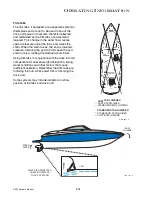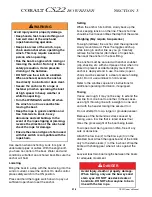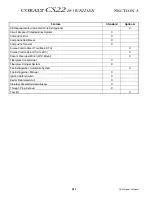
3
-
18
CS22 Owner’s Manual
COBALT
CS22
BOWRIDER
S
ECTION
3
Use caution when anchoring. Look for signs of
underwater pipes or cables. With the engine off,
you have no control of the boat. Water and wind
conditions will affect an anchored boat. Be sure the
anchor will hold.
Lowering
Bring the boat to a stop with the bow facing into the
wind or current. Lower the anchor. On dash control,
place safety switch in the ON position.
Press and hold the toggle switch down to pay out
sufficient rope/chain to set the anchor.
Setting
When the anchor hits bottom, slowly back up the
boat, keeping tension on the line. The anchor line
should be five to seven times the depth of the water.
Weighing (May require two persons)
To weigh (retrieve) the anchor, start the engine and
slowly move forward. Press the toggle switch up
while taking in anchor line as you go. Carefully
retrieve the last meter (36 inches) of rope/chain,
then seat the anchor in the bow fitting.
The anchor must be secured with anchor snubber
(clip, shackle, etc. with short piece of line) when it is
stored to prevent accidental deployment. When
anchor is deployed and in use, the rode (rope or
chain) must be secured to a cleat or secure holding
point. Do not use windlass to hold vessel.
Refer to the windlass operator’s instructions for
additional operating information, if equipped.
Towing
If seas are rough, it may not be easy to extend the
tow line from one boat to another. In these cases,
use a light throwing line with a weight on one end
and with the heavier towing line secured to it.
Do not attempt to tow a larger or grounded vessel.
Because of the tremendous stress caused by
towing, use a tow line that is rated at least four
times the gross weight of the boat being towed.
Tow ropes must be in good condition, free of any
cuts or abrasions.
Attach the tow line (2) to the bow eye (3) on the
disabled boat. Attach the opposite end of the bridle
only to the stern cleats (1) of the tow boat. Wrap the
bridle with chafing gear where it rubs against the
boat.
Leave at least two boat lengths between the boats
for adequate movement.
A
WARNING
Avoid injury and/or property damage.
• Keep hands, feet, loose clothing and
hair well clear of the winch and
rope/chain during operation.
• Keep clear view of the winch, rope,
chain and anchor when operating the
winch. This may require a second
person when operating.
• Run the boat’s engine while raising or
lowering the anchor. Not only is this a
safety precaution, it also prevents
draining of the batteries.
• DO NOT use the winch as a bollard.
When anchored, secure the anchor
line directly to a bollard or deck cleat.
• Secure the anchor with a rope or
fastener pin when operating the boat
at high speed, in heavy weather or
while transporting.
• Turn the WINDLASS switch off when
the winch is not in use and before
leaving the boat.
• Keep the rope in good condition and
free from twists, knots, heavy
abrasions and salt buildup. In the
event of the rope slipping or jamming,
reverse the direction of the winch and
check the rope for damage.
• Ensure the size and type of chain used
with this switch is compatible with the
rope/chain.
A
DANGER
Avoid injury, death or property damage.
When towing, only use the bow eye and
stern eyes. DO NOT use deck cleats or
handrails. DO NOT allow anyone to be in
line with the tow rope.
Summary of Contents for CS22
Page 2: ...ii CS22 Owner s Manual COBAL T CS22 BOWRIDER ...
Page 8: ...viii CS22 Owner s Manual COBAL T CS22 BOWRIDER NOTES ...
Page 60: ...2 30 CS22 Owner s Manual COBAL T CS22 BOWRIDER SECTION 2 NOTES ...
Page 102: ...4 4 CS22 Owner s Manual COBAL T CS22 BOWRIDER SECTION 4 ...
Page 124: ...6 10 CS22 Owner s Manual COBAL T CS22 BOWRIDER SECTION 6 NOTES ...
Page 132: ...7 8 CS22 Owner s Manual COBAL T CS22 BOWRIDER SECTION 7 NOTES ...
















































